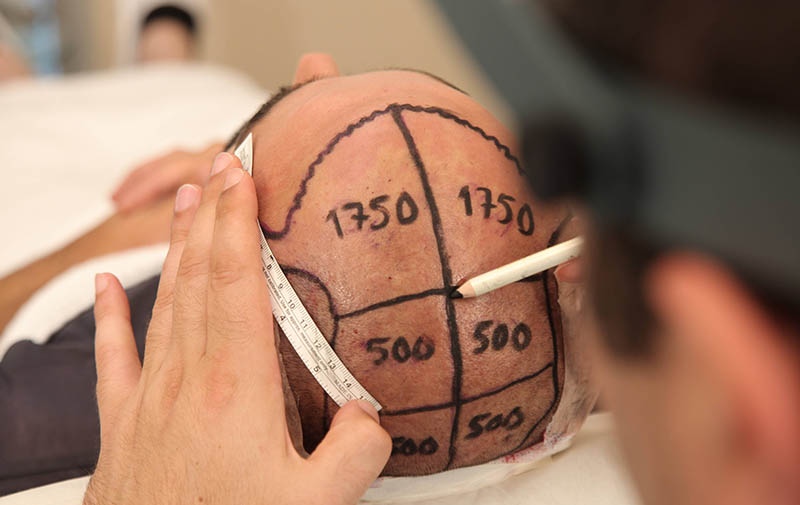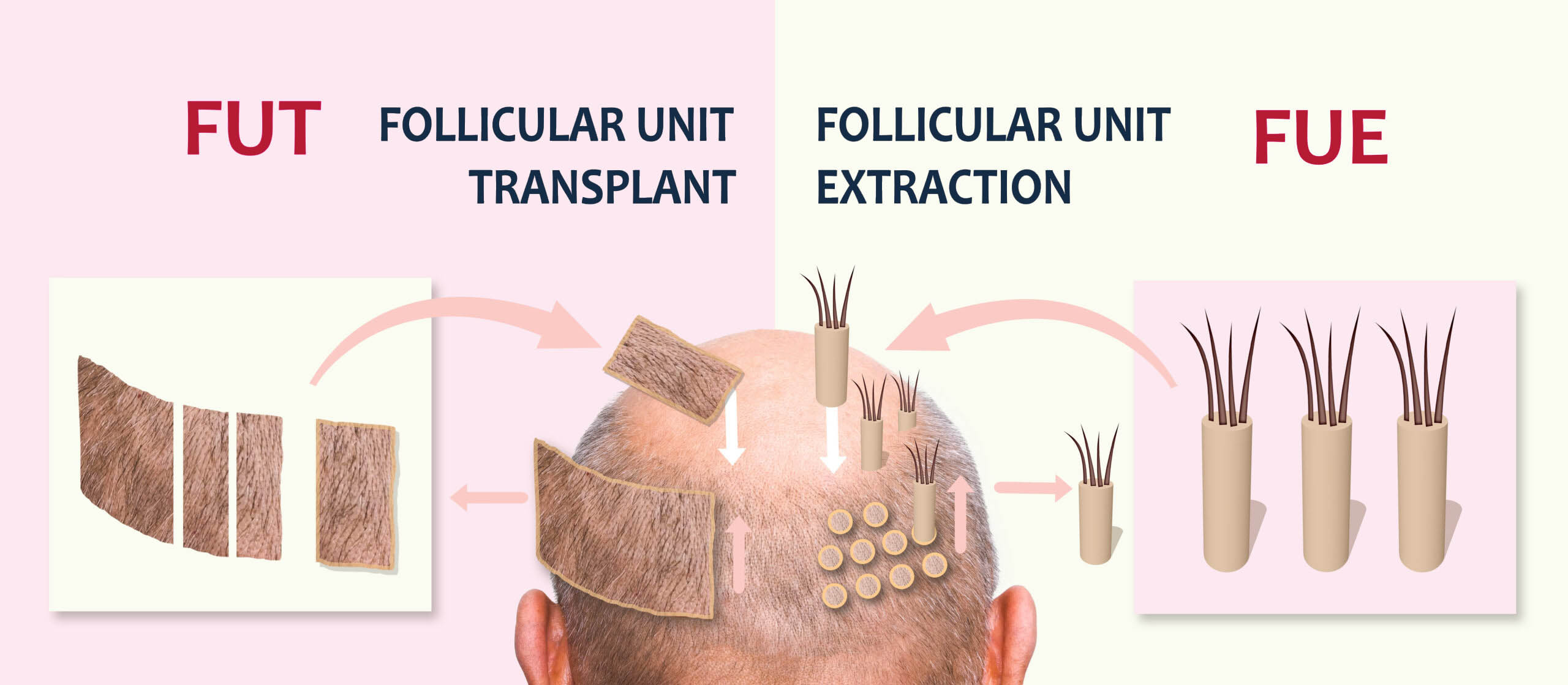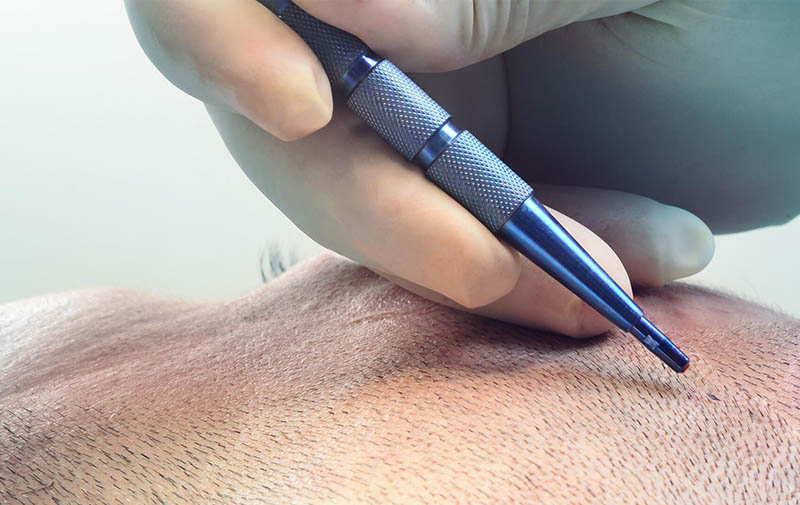
What exactly is a Follicular Unit Transplant (FUT) procedure, particularly in the context of hair transplantation in Turkey? Hair loss is a prevalent concern, affecting approximately 85 percent of men and 40 percent of women. FUT, along with other hair transplant techniques, represents minimally invasive surgical solutions designed to address bald spots resulting from hair loss.
The history of hair transplants dates back to at least 1939 in Japan, with early results often yielding unnatural and plug-like appearances. However, a significant breakthrough occurred in 1995 when surgeons began transplanting individual hair follicles, also known as follicular units, leading to more natural-looking outcomes.
Currently, two primary types of hair transplantation techniques are widely employed:
- Follicular Unit Extraction (FUE)
- Follicular Unit Transplantation (FUT)
FUT surgery involves the removal of a strip of skin from the back or side of the head, from which individual hair follicles are extracted. These follicles are then strategically implanted into the areas of the scalp experiencing baldness. This surgical approach is particularly effective for addressing receding hairlines associated with male pattern baldness.
For those considering FUT surgery, it’s essential to understand the procedure’s nuances, discover what to anticipate during the surgery, identify the ideal candidates, and discern the distinctions between FUT and the alternative method, FUE. In the specific context of hair transplantations in Turkey, the FUT technique is likely to be among the options available, providing individuals with a viable solution for restoring natural-looking hair growth.
How Follicular Unit Transplantation (FUT) Works:
Harvesting the Follicles:
- In FUT, a surgeon takes a strip of skin from the back of your head, typically not exceeding 1 to 1.5 centimeters (0.4 to 0.6 inches) wide. This strip contains the necessary follicles to cover bald areas.
Follicle Extraction and Insertion:
- Individual follicles are then carefully extracted from the strip and re-inserted into the balding parts of your scalp. This step is crucial for achieving a natural-looking outcome.
Duration of the Surgery:
- FUT surgeries typically last between 4 and 8 hours, making them generally quicker than Follicular Unit Extraction (FUE) surgeries. Local anesthesia is used to numb the scalp, and most people remain awake during the procedure.
Procedure Overview:
- The surgeon starts by re-drawing your hairline, marking the extraction area, and documenting the process through photographs. You might opt for a sedative for comfort.
- Local anesthesia is then applied to numb the scalp. Hair at the donor site is trimmed to about two millimeters.
- The surgeon cuts out the strip containing hair follicles, and you remain awake throughout.
- Technicians carefully extract individual follicles from the strip and prepare them for transplantation.
- The surgeon closes the scalp with sutures.
- The transplanted follicles are strategically inserted into the bald areas to create a natural pattern.
- Antibiotics and bandages are applied to the scalp for post-surgery care.
Results and Recovery:
- Most individuals begin to notice results within 6 to 9 months, though some may need to wait up to a year. Patience is key as the transplanted follicles take time to grow and integrate into the existing hair.
Understanding the step-by-step process of FUT can help individuals considering this procedure make informed decisions about their hair restoration journey.
What does Microscopic Follicular Unit Transplantation (MFUT) entail?
This term encompasses both FUT (Follicular Unit Transplantation) and FUE (Follicular Unit Extraction) hair transplantation techniques. Additionally, FUT surgery is alternatively known as Follicular Unit Strip Surgery (FUSS).
Who is a suitable candidate for a Follicular Unit Transplant (FUT) procedure
To be eligible for both FUT and FUE transplants, it’s crucial to have sufficient hair on your head for grafting. Men experiencing androgenic alopecia, commonly known as male pattern baldness, are optimal candidates for FUT. In men, this type of baldness often manifests in the Norwood pattern or an M-shaped hairline with receding temples. For women with androgenic alopecia, the Ludwig pattern is common, resulting in hair loss along the hair part or thinning at the top of the head.
It’s important to note that if an underlying medical condition such as a thyroid disorder or alopecia areata is the cause of your hair loss, FUT surgery may not be a viable option.
Factors that contribute to being a suitable candidate for FUT surgery include:
1- Age
FUT is generally recommended for individuals over the age of 25, as hair loss patterns tend to be more predictable in this age group.
2- Diagnosis
Men exhibiting the Norwood pattern of hair loss typically respond well to hair transplantation procedures.
3- Hair Thickness
Individuals with high hair follicle density often achieve better coverage and results from FUT surgery.
4- Area of Balding
FUT is particularly effective for addressing hair loss at the front of the head.
5- Hair Color
Candidates with hair color similar to their skin tone are preferred, as this minimizes color contrast and contributes to more favorable outcomes.
Understanding these criteria is essential for individuals contemplating FUT procedures, especially in the context of seeking hair transplants in Turkey.

Comparing FUT and FUE Hair Transplants:
Both FUT and FUE procedures involve the transplantation of individual hair follicles. In FUT surgery, a surgeon cuts a strip of skin from the back or side of your scalp, extracting hair follicles from this strip. Conversely, in FUE surgery, the surgeon directly removes individual hair follicles from your scalp, omitting the initial step of taking a strip of skin.
Currently, FUE is the more prevalent surgical approach. Some of the benefits associated with FUE include:
- Quicker Healing Time
- Reduced Post-Surgery Pain
- Minimal Scarring
- Option to Use Hair from Other Body Parts
- Suitable for Individuals with Poor Hair Density
On the other hand, FUT offers certain advantages, such as:
- Preferred for Large Number of Hair Follicles
- Shorter Operation Time
- Cost-Effective Surgery
Understanding the distinctions between FUT and FUE is essential for individuals considering hair transplant procedures, allowing them to weigh the specific advantages of each method based on their unique needs and preferences.
Potential Side Effects and Precautions for FUT
Instances of complications following FUT are infrequent. The ample blood supply to the head facilitates swift healing and serves as a protective factor against infections, with less than one percent of individuals experiencing an infection post-surgery.
Potential complications may encompass:
- Hair appearing unnatural
- Formation of bumps or scarring
- Inflammation of hair follicles (folliculitis)
- Occasional bleeding
- Swelling
- Pain
- Numbness
- Formation of cysts
While complications are rare, being aware of these potential side effects is essential for individuals considering FUT, allowing for informed decision-making and appropriate precautions during the recovery process.
FUT Scarring
Following FUT surgery, a scar forms at the location where hair is extracted. Although the scar naturally diminishes with time, it is a permanent mark. The extent of the scar is contingent on the quantity of hair follicles utilized in the procedure. Typically concealed by your hair, the scar may become visible if you opt for a shorter hairstyle.
Shock Hair Loss
Shock hair loss, often termed as donor hair effluvium, is a prevalent phenomenon where transplanted hair sheds within two months post-surgery. Fortunately, the lost hair typically regrows within four months.
Cost of FUT Hair Transplant in Turkey
The typical expense for an FUT hair transplant in Turkey ranges from $4,000 to $10,000, and prices may exceed this range at certain clinics.
Several factors influence the overall cost, including:
Volume of Transplanted Hair
Most clinics determine costs based on the number of transplanted hair follicles, although some may offer a fixed price.
Surgeon’s Fee
Prices can vary depending on the clinic and the expertise of the surgeon.
Location
FUT surgery costs may differ between clinics in various cities.
Travel Expenses
If travel is necessary for the surgery, budgeting for additional travel costs is advisable.
It’s important to note that FUT is typically considered a cosmetic surgery, making it unlikely for insurance to cover the expenses. However, in certain cases where hair loss results from burns or trauma, insurance coverage might apply.
For those concerned about upfront costs, some clinics offer payment plans that allow the expense to be spread across several installments.
Key Points to Remember
FUT surgery involves harvesting hair follicles from the back or side of your scalp to address bald areas. When performed by a skilled surgeon, it is generally safe and can yield a natural-looking outcome. However, it is important to note that the procedure leaves a permanent scar at the site of hair extraction. If you typically prefer shorter hairstyles, FUE surgery might be a more suitable alternative to consider.





